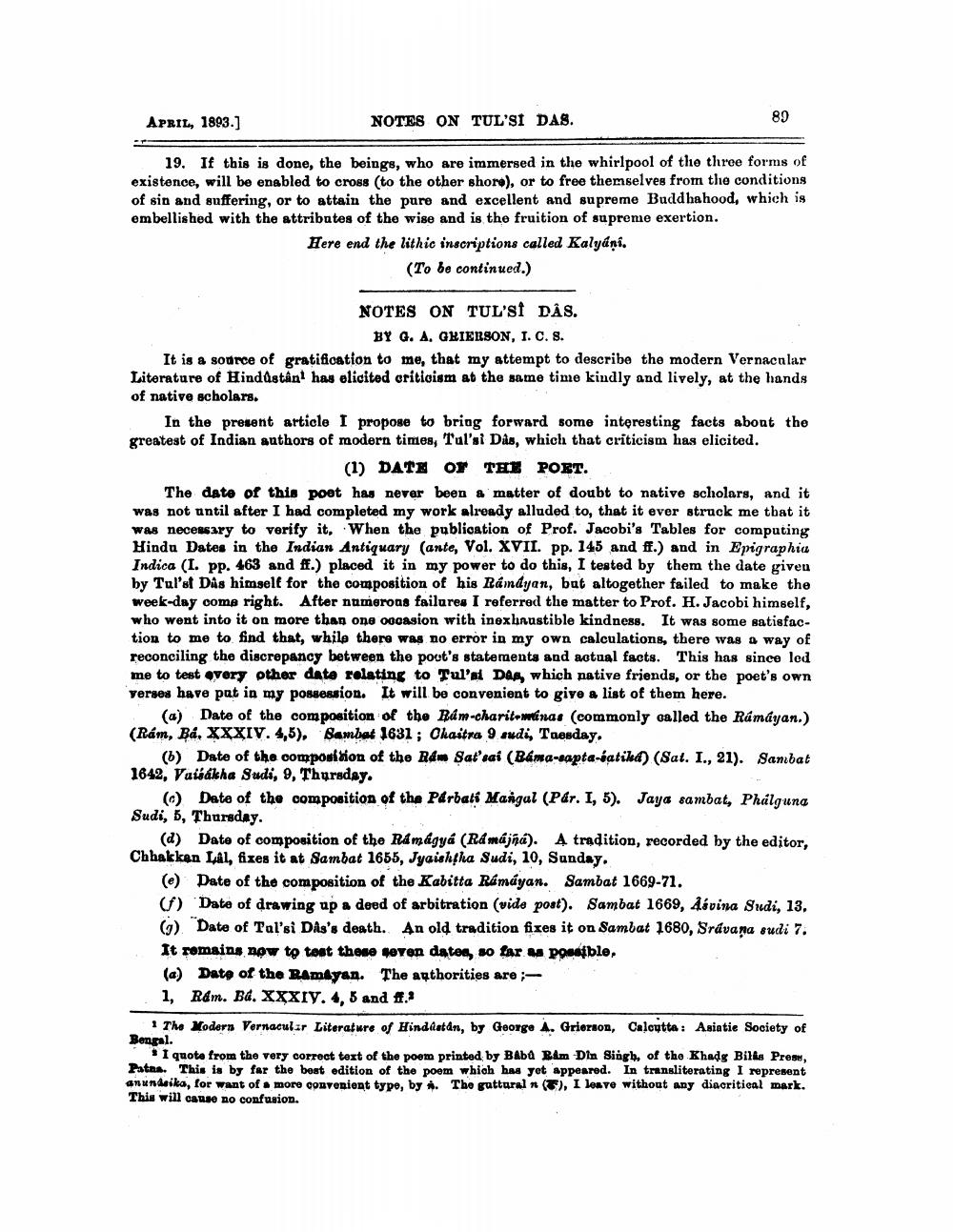________________
APRIL, 1893.]
NOTES ON TUL'SI DAS.
89
19. If this is done, the beings, who are immersed in the whirlpool of the three forms of existence, will be enabled to cross to the other shore), or to free themselves from the conditions of sin and suffering, or to attain the pure and excellent and supreme Buddhahood, which is embellished with the attributes of the wise and is the fruition of supreme exertion.
Here end the lithic inscriptions called Kalydni.
(To be continued.)
NOTES ON TUL'Sf DÂS.
BY G. A. GHIERSON, 1. C. 8. It is a source of gratification to me, that my attempt to describe the modern Vernacular Literature of Hindustani has elicited criticism at the same time kindly and lively, at the hands of native scholars.
In the present article I propose to bring forward some interesting facts about the greatest of Indian authors of modern times, Tulsi Das, which that criticism has elicited.
(1) DATE OF THE POET. The date of this poet has never been & matter of doubt to native scholars, and it was not until after I had completed my work already alluded to, that it ever struck me that it was necessary to verify it. When the publication of Prof. Jacobi's Tables for computing Hindu Dates in the Indian Antiquary (ante, Vol. XVII. pp. 145 and ff.) and in Epigraphia Indica (1. pp. 463 and if.) placed it in my power to do this, I tested by them the date given by Tul'st Das himself for the composition of his Rándyan, but altogether failed to make the week-day come right. After numerous failures I referred the matter to Prof. H. Jacobi himself, who went into it on more than one occasion with inexhaustible kindness. It was some satisfaction to me to find that, while there was no error in my own calculations, there was a way of reconciling the discrepancy between the poot's statements and actual facts. This has since led me to test every other data relating to Tul'al Day, which native friends, or the poet's own verses have pat in my possession. It will be convenient to give a list of them here.
(a) Date of the composition of the Rám-charit-wina. (commonly called the Rámayan.) (Rám, Bd. XXXIV. 4,5), Bambat 1631 ; Chaitra 9 sudi, Tuesday.
(6) Date of the composition of the Ram Sat'sai (Bama-sapta-batikd) (Sat. I., 21). Sambat 1642, Vaisakha Sudi, 9, Thursday.
) Date of the composition of the Parbati Mangal (P&r. I, 5). Jaya sambat, Phalguna Sudi, 6, Thursday.
(d) Date of composition of the Ramágyá (Rd májña). A tradition, recorded by the editor, Chhakkan Lal, fixes it at Sambat 1655, Jyaishtha Sudi, 10, Sunday.
(e) Date of the composition of the Kabitta Rámáyan. Sambat 1669-71. (1) Date of drawing up a deed of arbitration (vide post). Sambat 1669, Lévina Srdi, 13, G) Date of Talsi Das's death. An old tradition fixes it on Sambat 1680, Srávana sudi 7. It remains now to test these seven daten, so far w poble, (a) Date of the Ramayan. The authorities are ;
1, Råm. Bd. XXXIV. 4, 5 and if. · The Modern Vernacular Literature of Hindistan, by George A. Grierson, Calcutta : Asiatic Society of Bengal.
I quote from the very correct text of the poem printed by Baba Ram Din Singh, of the Khadg Bills Presu, Patna. This is by far the boat odition of the poem which has yet appeared. In transliterating I represent anundeika, for want of a more convenient type, by A. The gutturaln (T), I leave without any diacritical mark. This will cause no confusion.




